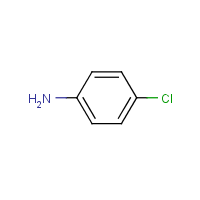4-Chloroaniline
Agent Name
4-Chloroaniline
CAS Number
106-47-8
Formula
C6-H6-Cl-N
Major Category
Nitrogen Compounds

Synonyms
1-Amino-4-chlorobenzene; 4-Amino-1-chlorobenzene; 4-Aminochlorobenzene; 4-Chloranilin [Czech]; 4-Chloro-1-aminobenzene; 4-Chlorobenzamine; 4-Chlorobenzenamine; 4-Chlorophenylamine; Aniline, 4-chloro-; Aniline, p-chloro-; Benzenamine, 4-chloro-; Benzeneamine, 4-chloro; p-Aminochlorobenzene; p-CA; p-Chloraniline; p-Chloroaniline; p-Chlorophenylamine; [ChemIDplus] UN2018
Category
Amines, Aromatic
Description
Colorless, white, or pale-yellow solid with a characteristic sweet odor; [HSDB] Light tan chips or crystalline solid; [MSDSonline]
Sources/Uses
Used as a chemical intermediate for dyes, pharmaceuticals, agricultural chemicals, and urea herbicides; [HSDB]
Comments
An eye irritant; Inhalation of high concentrations can cause methemoglobinemia; [ICSC] Toxic by ingestion, inhalation, or skin absorption; [CAMEO] May be a skin sensitizer based on animal studies; [CHEMINFO] May cause skin sensitization; [eChemPortal: ESIS] In the past, cases of severe methemoglobinemia were reported in workers manufacturing this chemical; Evidence of liver and kidney injury in high-dose animal experiments; 3-15% methemoglobin levels induced in rats at a dose of 13-40 mg/kg; [HSDB] An irritant; May cause skin sensitization; Effects in high-dose animal studies include convulsions, methemoglobinemia, and cyanosis; [MSDSonline] Danger of cutaneous absorption; Danger of skin sensitization; [MAK]
Biomedical References
Exposure Assessment
BEI
Methemoglobin in blood = 1.5% of hemoglobin during or at end of shift. [ACGIH]
Vapor Pressure
0.027 mm Hg
Lethal Concentration
LC50 (rat) = 2,340 mg/m3/4h
Explanatory Notes
Flash point = 120-123 deg C; [ICSC] The Guide in the Emergency Response Guidebook is for "Chloroanilines, solid." VP from ChemIDplus;
Adverse Effects
Skin Sensitizer
Yes
Methemoglobinemia
MetHgb is primary toxic effect
Hepatotoxin
Hepatoxic (a) from occupational exposure (secondary effect) or (b) in animal studies or in humans after ingestion
IARC Carcinogen
Possible (2b)
Diseases, Processes, and Activities Linked to This Agent
Diseases
Occupational diseases associated with exposure to this agent: